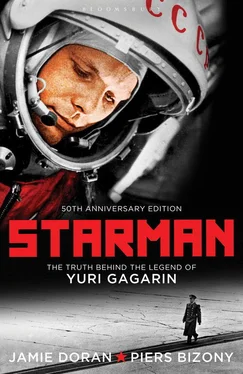They pulled him out, covered in burns and in great pain. ‘It’s my fault! I’m so sorry!’ he cried. The doctors struggled for eight hours to save him, but his injuries were too extreme. The circumstances of his death were not made public until 1986. [5] Heppenheimer, T.A., Countdown , New York: John Wiley & Sons, 1997, pp. 188–9. See also: Harford, Korolev , p. 242, and Hooper, The Soviet Cosmonaut Team , Vol. 1: ‘Background Sections’, pp. 172–3. For a general analysis of Soviet cosmonaut fatalities and hidden rocket failures, see Oberg, James, Uncovering Soviet Disasters , London: Robert Hale, 1988, pp. 156–97.
There was one aspect of space flight for which the cosmonauts at Star City had no practical means of preparing themselves in advance: weightlessness. Korolev and his advisors were not keen to allow their first manned spacecraft to drift in space for longer than a single orbit, because no one was sure that its passenger could survive an entire day without the normal sensation of gravity.
Weightlessness presented a tremendous psychological barrier for the early Soviet space programme. The only earth-bound opportunity to taste the sensation was in the 28-storey lift shaft at Moscow State University, one of the city’s tallest buildings. There was a special cage that fell freely down the shaft and slammed into compressed-air buffers at the bottom of its drop. The cosmonauts might float freely of the cage’s floor for two or three seconds at best. Korolev’s guidance specialist Yuri Mazzhorin explains, ‘It was our first dive into an ocean of uncertainty. We were afraid of everything. That’s why Sergei Pavlovich was in favour of a gradual approach. For the first human space mission, one circle. The next flight, twenty-four hours. The next, three days, to see how a person would survive.’
American astronauts at NASA flew long parabolic arcs aboard Boeing 707 jet planes. These craft were essentially cargo-carrying airliners, but with all the seats and storage crates stripped out, so that the interior cabin was a capacious free space. The astronauts could float free of the walls for perhaps two minutes at a time – more than enough to eliminate the sinister mystique of weightlessness. The Russians never thought to use their cargo planes in this way, at least not in the early 1960s. Trainee cosmonauts experienced thirty seconds or so of near-weightlessness while jerking about in the back seat of a MiG-15 fighter aircraft flying a similar parabolic arc, but it was barely more useful than plunging down the lift shaft at Moscow State University. Titov recalls the MiG experience being uncomfortable and unsatisfactory, and so short that it was not much more than he was used to on ordinary combat training missions. ‘When you’re performing an advanced manoeuvre and not doing it well, you might get something similar, and all the dirt and dust on the cockpit’s floor flies into your face. These short bursts aren’t weightlessness as such. It’s very different [in space] when you have to live in a weightless environment for long periods.’ What’s more, the MiG cockpits were so cramped that there was little chance to float about in any meaningful way.
The Soviets’ dread of weightlessness remained unconquered, at least for now. Calculations were made to fire Vostok’s braking rockets well within its first orbit, which would keep the period of weightlessness to a minimum. However, there was the remote possibility that the craft might be stuck in orbit for several more circuits, because of a failure in the retro-rockets. Andy Aldrin neatly sums up the risk faced by the world’s first space traveller: ‘In an orbital trajectory what happens is you go up and around the earth, and then the rocket that got you up there has to work again to slow you down and bring you back in. If that doesn’t work, you end up with a man orbiting the earth for ever and essentially dying… Korolev’s designers suggested a safer sub-orbital trajectory for the first manned attempt, but he made it clear he didn’t want to beat the Americans by such a little margin. He wanted to beat them by a lot.’
Vostok’s air supply (sixteen spherical gas tanks, alternating nitrogen and oxygen reservoirs wrapped in a ‘necklace’ around the join between the ball and the equipment module) would last for a maximum of ten days. The ship’s orbit was deliberately designed to skim the outermost layers of the earth’s atmosphere so that, in the event of a serious problem, natural atmospheric friction would slow the craft down within a few days. It was a gamble whether or not this would happen before the cosmonaut ran out of air, water and food.
With help from Academician Keldysh and his computers in Moscow, Mazzhorin calculated that Vostok’s re-entry ball could be recovered safely at the end of its first orbit, so long as the braking rockets in the rear equipment module functioned without incident. But even if these rockets were in good shape, there was a chance that the braking manoeuvre might have to be delayed while Vostok’s orientation was fine-tuned. In theory the retro-systems could be fired at any time, but there was no guarantee that they would bring the capsule down anywhere within Soviet-held territory.
Vostok’s orbit was inclined to the Equator by sixty-five degrees. Each orbit, west to east, took ninety minutes. Meanwhile the earth rotated at its own steady pace beneath the ship, once every twenty-four hours. As a consequence the craft did not fly the same path over the ground each time. The mathematics of the situation were clear. The best opportunities for a good homecoming occurred one hour into the first orbit, or else a whole day later, halfway through orbit seventeen. Firing the retro-rockets during any other orbit would risk bringing the craft down into the sea, or on foreigners’ land; in which case, the embarrassment could be severe. Secrets of technology might be revealed; corrupt capitalists might claim the glory for ‘rescuing’ a cosmonaut within their own borders.
Eventually the solutions to these potential propaganda problems were sealed within three envelopes, addressed to the official news agency TASS in Moscow. The various enclosed documents were prepared by Mazzhorin, doubling not just as a guidance mapper but also as a propaganda officer. He had such a detailed understanding of how and where the ball might come down, at the end of its flight, that it seemed appropriate for him to work out what measures should be taken if it actually did descend onto foreign soil. If this calamity occurred, then TASS would be instructed to tear open the appropriate envelope and broadcast its contents. Mazzhorin was also instructed to prepare for the very worst-case scenarios. If the capsule blew up in space, or the ball sprang a leak, then the press statements would have to be tailored accordingly to make the best of the situation. It seemed wise to consider all possibilities and prepare the various announcements in advance. ‘We prepared three envelopes for TASS, with different announcements,’ says Mazzhorin. ‘Envelope number one in case of a full success. Number two for a forced landing over foreign territory. Number three for a catastrophe. People in the television and radio stations were waiting. When we saw the cosmonaut had made it into orbit, and we had data, altitude, inclination and orbital period, the Kremlin could order TASS to open envelope number one.’
But even this ‘success’ envelope was not easy to compile. ‘When the capsule, suspended on parachutes, reached seven thousand metres, the cosmonaut was supposed to eject and come down under his own parachute. We weren’t sure whether to include this part.’
The problem was simple. In the event of a good flight, the Soviets intended to claim the World Aviation Altitude Record, according to rules established by international agreement. Korolev read these rules with care, and noticed to his alarm that any pilot claiming such a record had to remain inside his vehicle all the way to touchdown. If a pilot bailed out before landing, the rules assumed that something must have gone wrong with the flight. In which case, no record. The alternative was not to eject Vostok’s crewman, but Korolev was not sure that anyone could survive the re-entry ball’s abrupt landing without injury. Gai Severin, the foremost Soviet designer of fighter-pilot equipment, had already designed an emergency ejection seat for the cabin, just in case the R-7 launched badly and the cosmonaut had to get clear of some terrible explosion. If the same system was used to remove him at the end of his flight, there would be no need to worry if the ball came down rather too hard on the ground. Future re-entry modules would incorporate larger parachutes and a cluster of rockets in the base to soften the final impact. In later years, more powerful upper stages for the R-7 would allow larger and better-equipped ships to be hauled aloft. For now, the power-to-mass calculations for the system allowed Vostok no margin for luxuries. Soft-landing rockets for the ball were not an option, and its crewman had no choice but to eject.
Читать дальше












